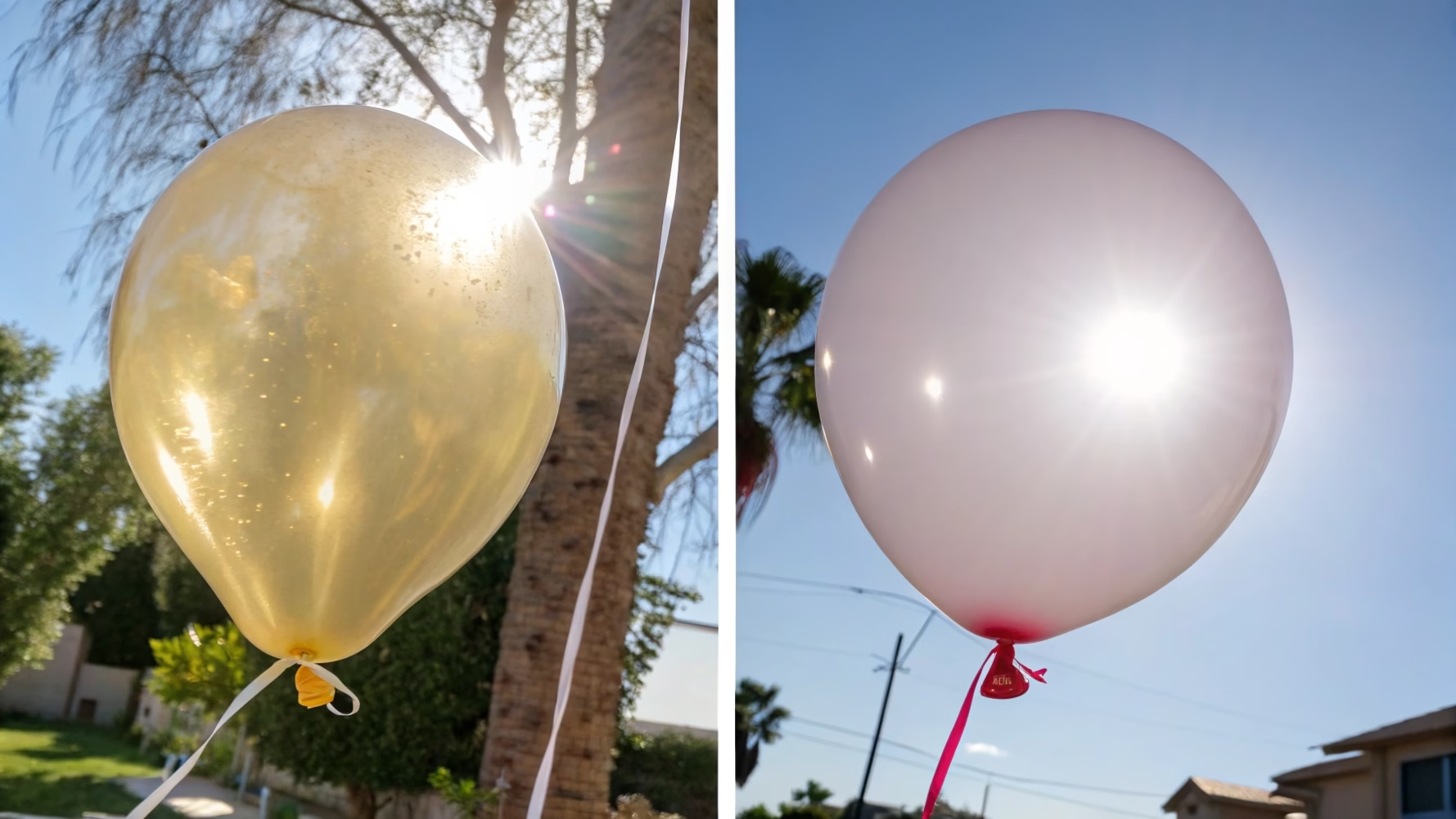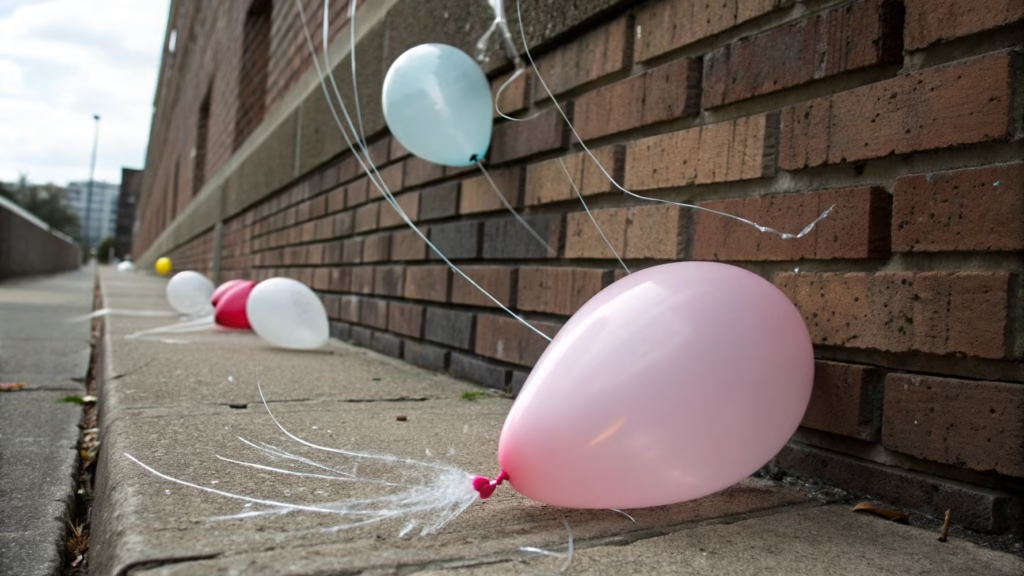Latex vs Mylar Balloons: How do they perform in different weather conditions?
As a balloon procurement manager, you face constant pressure to secure quality products that perform well. Are you struggling to predict how your balloons will hold up in various climates? Understanding balloon material performance is crucial for reliable inventory.
Latex and Mylar balloons show similar performance in most natural weather. Both types work well in moderate conditions. Extreme weather, like strong winds or heavy rain, is not ideal for either. Choosing the right balloon often depends more on the specific event and less on minor differences in material resilience to typical weather changes.

"Latex vs Mylar Balloons: Weather Performance"
As I have walked through many factories, I've seen firsthand how both latex and Mylar balloons are made. This has given me a deeper insight into their strengths and weaknesses in different environments. It has shown me that understanding these differences is key to making smart procurement choices for any event.
Which balloon material offers better durability in high heat?
Procurement managers often worry about balloons losing their appeal or bursting too soon in warm climates. Does high heat quickly degrade one type over the other? Knowing this can prevent costly event failures.
In high heat, Mylar balloons generally maintain their integrity longer than latex balloons. Mylar's non-porous surface resists gas escape and expansion breakage better. Latex balloons, being porous, can soften, over-expand, and even burst more easily in direct, intense heat due to increased internal gas pressure and material weakening.

When I think about trips to hot countries, I remember seeing balloons at outdoor events. Mylar balloons often looked better for longer. Latex balloons, especially those filled with air and not helium, can sag and feel sticky in very high temperatures. This is because latex is a natural material. It can react to heat by softening. Helium inside latex balloons expands more quickly in heat. This raises the internal pressure. If the balloon is already fully inflated, it can burst. Mylar, which is a metalized film, does not have this issue as much. It is designed to be more stable. It does not soften in heat in the same way. It will still expand, and too much expansion can cause bursting. But its material structure gives it an edge. Here is a simple comparison:
| Feature | Latex in High Heat | Mylar in High Heat |
|---|---|---|
| Material | Natural rubber | Metalized nylon foil |
| Porosity | Porous | Non-porous |
| Expansion | Expands significantly, higher burst risk | Expands, but material is more stable |
| Appearance | Can soften, become dull | Maintains shine, less affected |
| Float Time | Reduced due to faster helium escape | Maintains float time better due to less gas leak |
High temperatures also affect float time. Helium escapes faster from porous latex in heat. This means latex balloons will deflate sooner. Mylar balloons hold gas better. So, they maintain their float time longer. This is an important detail for events planned for hot days.
Are latex or Mylar balloons more resistant to cold weather deflation?
When clients plan winter events, a common concern is balloons deflating quickly. Does one material withstand cold better? Understanding this helps in choosing the right product for cold climates.
Mylar balloons are more resistant to cold weather deflation than latex balloons. Cold temperatures cause helium to contract, which reduces balloon volume. Mylar's non-porous nature and rigid structure keep its shape better. Latex, being elastic and porous, shrinks more noticeably and loses gas at a slightly faster rate in very cold conditions.

I recall an outdoor charity run in winter. The Mylar balloons looked full and shiny throughout the event. The latex balloons, especially those outside for many hours, looked a bit smaller. This is because helium, like all gases, shrinks when it gets cold. When helium shrinks inside a latex balloon, the latex material also contracts. It becomes less elastic. This can make the balloon look underinflated. Plus, if the latex is very cold, its tiny pores might allow minute amounts of gas to escape more easily, though this effect is usually minor. Mylar balloons, made of foil, do not shrink in the same way. The foil maintains its shape better. Even though the helium inside contracts, the Mylar balloon looks less affected by the cold. It just appears a little less firm. Once brought back to warmth, the helium expands again. The Mylar balloon will look full again. Latex balloons will also re-expand, but the initial cold deformation can be more visible. This difference is important for outdoor winter displays.
How does humidity affect the float time of Mylar versus latex balloons?
Planning events in humid areas brings questions about balloon longevity. Does high humidity drastically change how long balloons float? Knowing this helps you advise clients better.
Humidity has a minimal direct effect on the float time of Mylar balloons because their sealed, non-porous surface blocks moisture. For latex balloons, high humidity can slightly reduce float time. This happens because water vapor can penetrate the latex material, increasing its weight and also slightly affecting the rate of gas diffusion from the porous surface.

I remember talking with a supplier about balloon testing in a very humid climate. They told me that Mylar balloons were largely unaffected. Their outer layer is like a shield. Water cannot get in or out. This keeps the helium safe inside. So, the float time stays consistent. Latex balloons are different. Latex is a natural product and is porous. In very humid conditions, tiny water molecules can pass through the balloon wall. This adds a small amount of weight to the balloon. This extra weight can reduce how long the balloon floats. Also, the moisture can slightly affect the integrity of the latex itself, making it a bit softer. This can lead to a slight increase in helium escape. However, this effect is usually not very dramatic for most events. It becomes more noticeable in extremely high and prolonged humidity. For most common uses, both types of balloons will perform well. The difference in float time due to humidity is often minor. Here are some factors:
| Factor | Latex in High Humidity | Mylar in High Humidity |
|---|---|---|
| Material | Porous, natural rubber | Non-porous, metalized film |
| Moisture | Can absorb slight moisture, adding minimal weight | Impermeable to moisture |
| Weight | Might gain a negligible amount of weight | Weight remains constant |
| Gas Escape | Very slight increase in helium diffusion possible | No change in helium diffusion due to humidity |
| Float Time | Minor reduction in very high humidity conditions | Float time remains stable |
| Appearance | Appearance generally unaffected by humidity alone | Appearance generally unaffected by humidity alone |
Overall, the impact of humidity is less significant than temperature changes for both balloon types.
In windy conditions, do latex or Mylar balloons have a higher burst risk?
Windy conditions are tricky for any outdoor event. Do Mylar or latex balloons handle strong gusts differently? Knowing the burst risk helps make informed decisions for product selection.
In windy conditions, both latex and Mylar balloons have a similar risk of bursting. Wind itself does not directly cause bursting but pushes balloons into sharp objects or surfaces. Latex balloons are more likely to tear or pop on rough surfaces due to their elasticity. Mylar balloons can crease or crinkle, potentially leading to tears, but their smoother surface might slide over some obstacles.

I have seen countless outdoor events where balloons are used. The biggest danger in wind is not the wind hitting the balloon itself. It is the wind pushing the balloon into something else. Think of balloons tied to a pole. A strong gust can pull them hard. If they scrape against a rough wall, a tree branch, or even the pole itself, they can burst. Latex balloons are soft and stretchy. When they hit a sharp edge, they are more likely to snag and tear. Picture a latex balloon rubbing against a brick wall. It will likely pop. Mylar balloons are made of a thin foil. They are stiffer. If a Mylar balloon hits a rough surface, it might get a crease or a crinkle. This could lead to a tear along the crease. However, because they are smoother, they might sometimes slide over obstructions better than latex. But if the friction is too strong, or the impact is sharp, they will tear. Neither material is designed for very strong winds. Both will have problems. The best solution for wind is often to avoid using balloons or to secure them very well.
| Factor | Latex in Wind | Mylar in Wind |
|---|---|---|
| Material | Elastic, prone to snagging and tearing | Stiffer foil, prone to creasing and tearing |
| Impact Risk | Higher risk of tearing/popping on rough surfaces | Risk of tearing along creases or sharp impacts |
| Shape | Can deform significantly, then snap back (if not burst) | Maintains shape better, but can crinkle |
| Movement | Floats and sways with wind, potentially hitting objects | Floats and sways with wind, potentially hitting objects |
| Durability | Lower resistance to sharp impacts or friction | Moderate resistance to impacts, but can still tear |
For high wind, the risk comes from contact with external objects. Not from the wind pressure on the balloon itself.
Conclusion
Understanding how latex and Mylar balloons react to different weather helps you make better choices. Both perform well in normal conditions. Extreme weather makes both types challenging.
